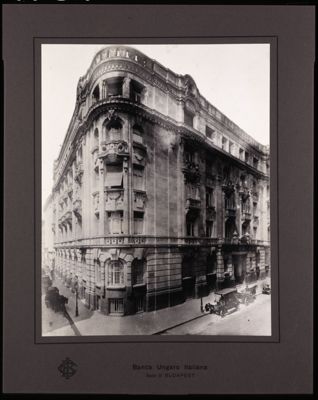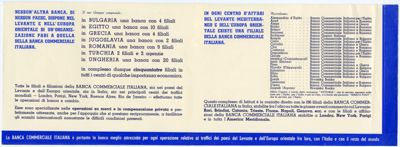| description |
Banca Ungaro-Italiana (Bankunit) was created on 19 April 1920 by the Italo-Austrian financier Camillo Castiglioni, through the merger of Credit Institut Ungarischer Holzhändler and Ungarische Landesbank & Agrar Bank. Banca Commerciale Italiana (BCI) decided to participate with a group of Italians, the founders of a company named Foresta, acquiring 38% of the shares.
According to its statute, the bank's task was to advance the financial, agricultural and commercial interests of the Kingdom of Hungary, in part through the use of Italian capital, and to facilitate financial and commercial relations between Hungary and Italy.
From the start BCI exercised a great deal of control over the new bank: Giuseppe Toeplitz, then the managing director of BCI, was the Vice-President of its first Board of Directors, where he was joined by board members Gilberto Borromeo and Enrico di San Martino Valperga (both members of BCI's Board of Directors as well) and Mino Gianzana (BCI's senior manager). During the 1920s BCI became Bankunit's majority shareholder, increasing its stake to 75%.
At the time Hungary was undergoing a phase of monetary inflation, later followed by one of credit inflation, due to a glut of foreign credit. In order to improve the country's monetary situation an international loan was issued in 1924; Italy took part in the operation, with BCI acting as the largest private underwriter.
Bankunit had focused on providing agricultural and mortgage loans to Magyar landowners, selling mortgage bonds to its American and British sister companies in order to obtain hard currency to lend to Hungarian farmers. Currency devaluation and the collapse of agricultural prices therefore made it very difficult for the bank to prosecute debtors. Starting in 1931 Bankunit was forced to undertake a major internal restructuring, and to liquidate several branches.
Until that time, thanks to BCI, Bankunit had been able to expand rapidly throughout the country: in addition to its head office, it had nine city-based agencies in Budapest, eleven provincial agencies (in Békéscsaba, Hatvan, Hòdmezövásárhely, Körmend, Makó, Miskolc, Nyiregyháza, Orosháza, Sátoraljaujhely, Szeged and Szombathely) and nine affiliated institutions (in Abony, Gyöngyös, Karcag, Kisvárda, Mezötúr, Paks, Sárospatak, Szolnok and Tápiószele).
In 1948, following in the footsteps of other Balkan banks, Bankunit, too, was nationalized. |
| BIBLIOGRAPHY |
ASI-BCI, VCA; March 30, 1920; vol. 5, pp. 252-25
ASI-BCI, Miscellaneous papers of Raffaele Mattioli (M1), cart. 3
ASI-BCI, The papers of Managing Directors, Mattioli and Facconi (AD1 and AD2), cart. 8, fasc. 6, Bankunit
ASI-BCI, The papers of Mattioli's main collaborators, Malagodi, cart. 5, Memorandum, maggio 1936
ASI-BCI, Leo Valiani's activities abroad (VAL-E), cart. 3
|

